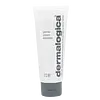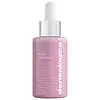What's inside
What's inside
 Key Ingredients
Key Ingredients

 Benefits
Benefits

 Concerns
Concerns

 Ingredients Side-by-side
Ingredients Side-by-side

Water
Skin ConditioningDiatomaceous Earth
AbrasiveButylene Glycol
HumectantC12-15 Alkyl Benzoate
AntimicrobialPrunus Armeniaca Kernel Oil
MaskingPapain
Skin ConditioningBromelain
Skin ConditioningSteareth-21
CleansingSteareth-2
EmulsifyingCetearyl Alcohol
EmollientSalicylic Acid
MaskingSodium Magnesium Silicate
Lactic Acid
BufferingAloe Barbadensis Leaf Extract
EmollientCentaurea Cyanus Flower Extract
AstringentCitrus Medica Limonum Fruit Extract
Skin ConditioningCitrus Aurantium Dulcis Flower Extract
Skin ConditioningChamomilla Recutita Flower Extract
MaskingPolysorbate 80
EmulsifyingDisodium EDTA
Benzyl PCA
HumectantPhenoxyethanol
PreservativeLinalool
PerfumingLavandula Angustifolia Oil
MaskingCI 77891
Cosmetic ColorantWater, Diatomaceous Earth, Butylene Glycol, C12-15 Alkyl Benzoate, Prunus Armeniaca Kernel Oil, Papain, Bromelain, Steareth-21, Steareth-2, Cetearyl Alcohol, Salicylic Acid, Sodium Magnesium Silicate, Lactic Acid, Aloe Barbadensis Leaf Extract, Centaurea Cyanus Flower Extract, Citrus Medica Limonum Fruit Extract, Citrus Aurantium Dulcis Flower Extract, Chamomilla Recutita Flower Extract, Polysorbate 80, Disodium EDTA, Benzyl PCA, Phenoxyethanol, Linalool, Lavandula Angustifolia Oil, CI 77891
Water
Skin ConditioningLactobacillus/Punica Granatum Fruit Ferment Extract
Skin ConditioningGlycolic Acid
BufferingAminomethyl Propanol
BufferingPhytic Acid
Gluconolactone
Skin ConditioningGlycerin
HumectantPropanediol
SolventLactic Acid
BufferingSalicylic Acid
MaskingTranexamic Acid
AstringentHydroxyacetophenone
AntioxidantSodium Hyaluronate
HumectantHydrolyzed Gardenia Florida Extract
AntioxidantZanthoxylum Bungeanum Fruit Extract
Skin ConditioningVaccinium Macrocarpon Fruit Extract
AstringentHelianthus Annuus Seed Oil
EmollientCitrus Aurantium Bergamia Fruit Oil
MaskingCitrus Nobilis Peel Oil
MaskingLeuconostoc/Radish Root Ferment Filtrate
AntimicrobialRaspberry Ketone
MaskingRosa Damascena Flower
Skin ConditioningSodium PCA
HumectantSucrose Distearate
EmollientSuccinoglycan
Skin ConditioningUrea
BufferingCeramide NP
Skin ConditioningPhytosphingosine
Skin ConditioningHydrogenated Lecithin
EmulsifyingCaprylyl Glycol
EmollientOleyl Alcohol
EmollientTriolein
Skin ConditioningCaprylic/Capric Triglyceride
MaskingOleic Acid
EmollientEthoxydiglycol
HumectantCholesterol
EmollientTrehalose
HumectantPolyquaternium-51
Skin ConditioningMaltodextrin
AbsorbentEthyl Acetate
PerfumingCaprylhydroxamic Acid
1,2-Hexanediol
Skin ConditioningPolyacrylate Crosspolymer-6
Emulsion StabilisingStearic Acid
CleansingGamma-Undecalactone
PerfumingWater, Lactobacillus/Punica Granatum Fruit Ferment Extract, Glycolic Acid, Aminomethyl Propanol, Phytic Acid, Gluconolactone, Glycerin, Propanediol, Lactic Acid, Salicylic Acid, Tranexamic Acid, Hydroxyacetophenone, Sodium Hyaluronate, Hydrolyzed Gardenia Florida Extract, Zanthoxylum Bungeanum Fruit Extract, Vaccinium Macrocarpon Fruit Extract, Helianthus Annuus Seed Oil, Citrus Aurantium Bergamia Fruit Oil, Citrus Nobilis Peel Oil, Leuconostoc/Radish Root Ferment Filtrate, Raspberry Ketone, Rosa Damascena Flower, Sodium PCA, Sucrose Distearate, Succinoglycan, Urea, Ceramide NP, Phytosphingosine, Hydrogenated Lecithin, Caprylyl Glycol, Oleyl Alcohol, Triolein, Caprylic/Capric Triglyceride, Oleic Acid, Ethoxydiglycol, Cholesterol, Trehalose, Polyquaternium-51, Maltodextrin, Ethyl Acetate, Caprylhydroxamic Acid, 1,2-Hexanediol, Polyacrylate Crosspolymer-6, Stearic Acid, Gamma-Undecalactone
 Reviews
Reviews

Ingredients Explained
These ingredients are found in both products.
Ingredients higher up in an ingredient list are typically present in a larger amount.
Lactic Acid is another well-loved alpha hydroxy acid (AHA). It is gentler than glycolic acid but still highly effective.
Its main role is to exfoliate the surface of the skin by loosening the “glue” that holds dead skin cells together. Shedding those old cells leads to smoother, softer, and more even-toned skin.
Because lactic acid molecules are larger than glycolic acid, they don’t penetrate as deeply. This means they’re less likely to sting or irritate, making it a great choice for beginners or those with sensitive skin.
Like glycolic acid, it can:
Lactic acid also acts as a humectant (like hyaluronic acid). It can draw water into the skin to improve hydration and also plays a role in the skin's natural moisturizing factor (NMF) in the form of sodium lactate.
Studies show it can boost ceramide production to strengthen the skin barrier and even help balance the skin’s microbiome.
To get results, choose products with a pH between 3-4.
Lower strengths (5-12%) focus on surface exfoliation; higher strengths (12% and up) can reach deeper in the dermis (deeper, supportive layer) to improve skin texture and firmness over time.
Though it was originally derived from milk, most modern lactic acid used in skincare is vegan. It is made through non-dairy fermentation to create a bio-identical and stable form suitable for all formulations.
When lactic acid shows up near the end of an ingredient list, it usually means the brand added just a tiny amount to adjust the product’s pH.
Legend has it that Cleopatra used to bathe in sour milk to help reduce wrinkles.
Lactic acid is truly a gentle multitasker: it exfoliates, hydrates, strengthens, and brightens. It's a great ingredient for giving your skin a smooth, glowing, and healthy look without the harshness of stronger acids.
Read more about some other popular AHA's here:
Learn more about Lactic AcidSalicylic Acid (also known as beta hydroxy acid or BHA) is a well-known ingredient for treating skin that struggles with acne and clogged pores. It exfoliates both the skin's surface and deep within the pores to help clear out buildup, control oil, and reduce inflammation.
Unlike AHAs (alpha hydroxy acids), salicylic acid is oil-soluble. This allows it to penetrate into pores which makes it especially effective for treating blackheads and preventing future breakouts.
Salicylic acid is also known for its soothing properties. It has a similar structure to aspirin and can calm inflamed or irritated skin, making it a good option for acne-prone skin that is also sensitive.
Concentrations of 0.5-2% are recognized by the U.S. FDA as an over-the-counter topical acne product.
It can cause irritation and/or dryness if one's skin already has a compromised moisture barrier, so it's best to focus on repairing that before introducing this ingredient into your routine.
While salicylic acid does not increase sun sensitivity, it’s still important to wear sunscreen daily to protect your skin.
If you are looking for the ingredient called BHA or Butylated Hydroxyanisole, click here.
Learn more about Salicylic AcidWater. It's the most common cosmetic ingredient of all. You'll usually see it at the top of ingredient lists, meaning that it makes up the largest part of the product.
So why is it so popular? Water most often acts as a solvent - this means that it helps dissolve other ingredients into the formulation.
You'll also recognize water as that liquid we all need to stay alive. If you see this, drink a glass of water. Stay hydrated!
Learn more about Water